Supply chain digitalisation via an IT platform
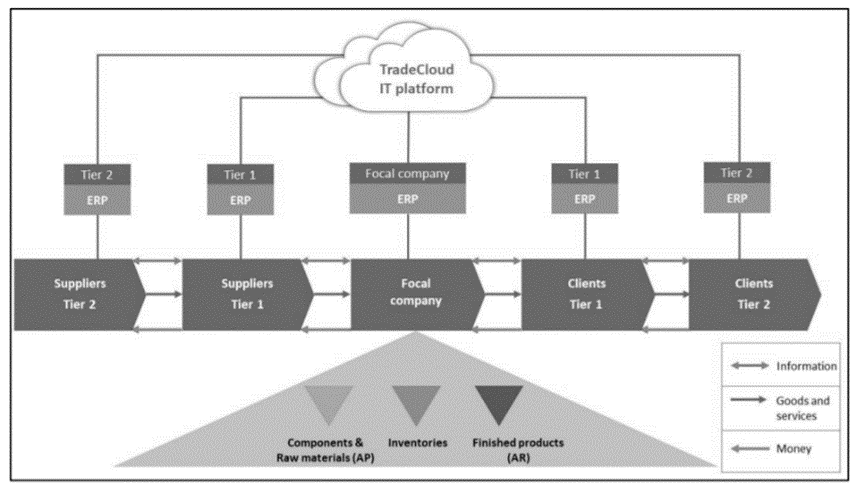
One of the most effective ways to improve your business visibility and alignment is integration with your suppliers/partners in your supply chain. People always say that. Books and other kinds of knowledge stuffs also prove that, but what exactly does it mean? You got any idea? Well, not with standing a “Yes”” or “No”, I would like to share with you some best examples on how an IT platform can connect different firms’ ERP systems, while improving its supply chain (SC) performance.
- What is an IT platform?
Integration of a supply chain through TradeCloud is shown in Figure 1 above (Jansen et al., 2021).
An IT platform acts as a centralized server hosted over a network and accessible by multiple users (e.g. a focal company, its suppliers and customers). Tradecloud is an example, which offers the following services to its customers: zero touch handling (e.g. no paper), real time insights (e.g. lead time), and communication in contexts. This IT platform was stem from the fast-paced technological development and turbulent environment, meaning it is no longer sufficient for companies to only use ERP systems. Thus, firms are expected to grow to another level where enables them to automate business processes, better collaborate and gain a clearer visibility of the whole SC. In order to achieve that, an intermediate tool needs to be in place to connect companies’ (ERP) systems. In this case, it is Tradecloud.
- How does it work?
Tradecloud, or other IT platforms, is accessible via an Internet browser by your electronic devices. Different IT platforms provide distinct customised functionalities, so the way an IT platform works depends on its functionalities and facilities. Most importantly, this kind of cloud platform helps your firm gain better SC visibility, thus eventually increasing ROI, supplier reliability, and firm agility whereas saving time and costs, and eliminating wastes.
- Successful practices
Let’s have a look at the following successful implementation of an IT platform in the industry.
#1: Heering-Holland – original equipment manufacturers (OEMs)
Goal: Better performance in SC finance metrics
Key impacts of applying an IT platform
- Automate Purchase-to-Pay and Order-to-Cash processes
- Reduce order handling costs, manufacturing lead time and delivery time, errors
- Self-managing SC (the workflow will automatically adjust itself if everything goes well)
- Classify products in terms of price changes
- Shorter Cash-to-Cash Cycle (C2C) of the focal company
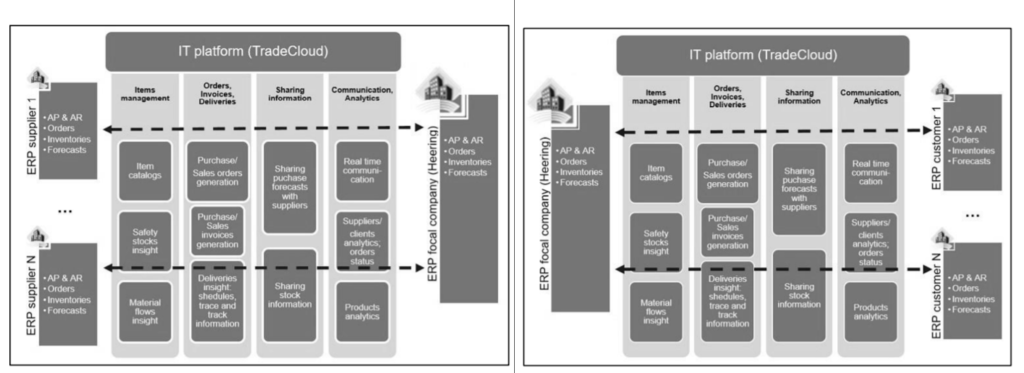
Figure 2 – Functionalities of TradeCloud and connection of the focal company Heering with its suppliers (left-side) and customers (right-side) through the TradeCloud platform (Jansen et al., 2021)
#2: NileDutch and TIP Trailer Services – logistics service providers
Goal: Improve fleet management
Key impacts of applying an IT platform
- Reduce fleet size
- Optimize planning (e.g. empty container plan 10 to 12 weeks in advance, which avoids container surplus)
- 95% demand accuracy 6 weeks ahead of time
- Increase revenue (e.g. TIP achieved 11% sales growth)
- Lower storage costs and lead time
#3: Parker Hannifin – manufacturer
Goal: Reduce customer dissatisfaction and inefficiency caused by fragmented approach
Key impacts of applying an IT platform
- Offer customers a unified way to browse and purchase products
- Create a seamless ordering process
- Boost customer satisfaction across 50 countries and sales
- Open up a larger market
- Optimize inventory control and more efficient order allocation and sourcing
- Better visibility into inventory and orders across global supply network
To sum up, it’s not surprising if a company has to manage around 5,000 employees, 15,000 suppliers, and millions of SKUs. Numbering these factors, again, emphasizes the significance of supply chain visibility, which now can be achieved via supply chain digitalization.
Thank you very much for reading and please share your opinions over this topic in the comment below!
Legends
*ERP – Enterprise Resources Planning
*ROI – Return on investment
*SKUs – Stock keeping units
References
Jansen, J. H. et al. (2021) CASE STUDY SUPPLY CHAIN FINANCE: IT PLATFORM FOR SMEs https://www.researchgate.net/publication/356810323_CASE_STUDY_SUPPLY_CHAIN_FINANCE_IT_PLATFORM_FOR_SMES
AI case study 3: Cost-saving AI in Manufacturing Logistics – Tradecloud (tradecloud1.com)’
https://www.ibm.com/case-studies/parker-hannifin-corporation
Series “Supply chain digitalisation“
-
Supplier’s Analysis Model
Find the balance between your organization and suppliers by using Supplier’s Analysis Model.
-
How to select the right suppliers for your supply chain? (Part 2)
Selection of the right suppliers for your supply chain (Part 2): suppliers evaluation and criteria of suppliers selection.
-
How to select the right suppliers for your supply chain? (Part 1)
Selecting the right suppliers for your supply chain using Market maturity curve model.
-
Can we all do procurement?
Procurement process, the Maturity Curve model, the Supplier’s analysis model, and the Kraljic Portfolio.
-
Supply chain digitalisation via an IT platform
Supply chain digitalisation via an IT platform which connects different companies’ ERP systems while improving the focal company’s supply chain performance.
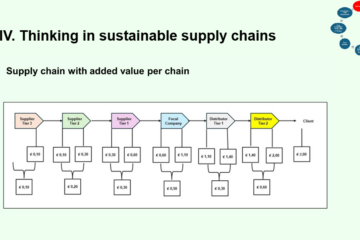
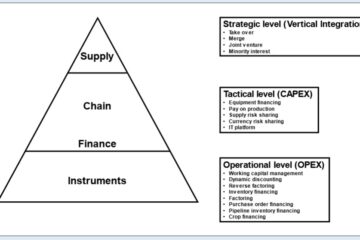
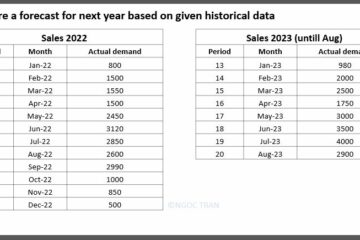
0 Comments